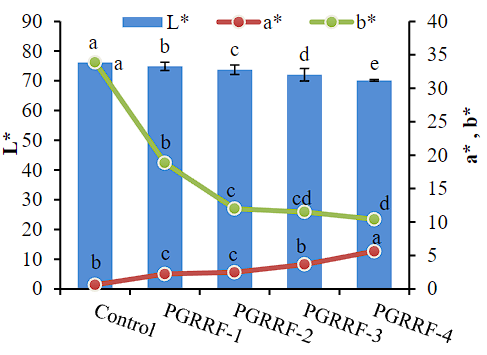Effect of Fat Substitution with Pre-gelatinized Riceberry Rice Flour on Physicochemical Properties, Sensory Acceptance and Shelf life of Salad Dressing
doi: 10.14456/mijet.2022.30
Keywords:
pre-gelatinized, riceberry rice, bioactive compounds, salad dressingAbstract
The objectives of this research was to study substitution of soybean oil with pre-gelatinized riceberry rice flour of Buriram in low fat salad dressing product at 0, 10, 20, 30 and 40 percent of soybean oil weight. Study on physical and chemical properties, sensory evaluation and shelf life. It was found that substitution of pre-gelatinized riceberry rice flour increased with decreasing of lightness (L*) and yellowness (b*) of salad dressing, but the redness (a*) was increased (p≤0.05). Total phenolic content, total anthocyanin content and antioxidant activity increased with increasing of pre-gelatinized riceberry rice flour (p≤0.05). The pH value not significant different were between 3.89-4.01. Lipid content tend to decrease with increasing of pre-gelatinized riceberry rice flour (p≤0.05). Sensory evaluated of fat substitute with pre-gelatinized riceberry rice flour of salad dressing was not significantly different (p>0.05). The best formula was substitution soy bean oil with 30% pre-gelatinized riceberry rice flour. Study on the shelf life of salad dressing was packed in plastic jar and stored at 4 °C for 28 days. It was found that decreasing of color value, total phenolic content, total anthocyanin content and antioxidant activity with longer of storage periods. Lipid oxidation increased with increasing of storage periods (p≤0.05). The result revealed that the total microorganism was not detected in salad dressing sample after storage at 4 ◦C for 28 days. Yeast and molds was found in the range of lower than 10 colonies (p≤0.05), the salad dressing was shelf life at about 28 days.
References
C. N. Schädle, S. Barder-Mittermaier, S. Sanahuja, “Characterization of reduce-fat mayonnaise and comparison of sensory perception, reological, tribological, and texture analyses,” Foods, 2022, pp. 1-20.
H. T. Tô, S. J. Karrila, L. H. Nga and T. T. Karrila, “Effect of blending and pregelatinizing order on properties of pregelatinized starch from rice and cassava,” Food Research, 2020, pp. 102-112.
X. Ding, L. Wang, T. Li, F. wang, Z. Quan, M. Zhou, Z. Huo, “Pre-Gelatinisation of rice flour and Its effect on the properties of gluten free rice bread and its batter,” Foods, 2648.
C. Thongkaew and J. Singthong, “Effect of partial substitution of riceberry rice flour on rice noodles quality,” Food Research, 2020, pp. 9-16.
N. Settapramote, T. Laokuldilok, D. Boonyawan and N. Utama-ang, “Physiochemical, Antioxidant Activities and Anthocyanin of Riceberry Rice from Different Locations in Thailand,” Food and Applied Bioscience Journal, 2018, pp. 84-94.
Z. Ma, J.I. Boye, J. Fortin, B. K. Simpson and S. O. Prasher, “Rheological, physical stability, microstructural and sensory properties of salad dressings supplemented with raw and thermally treated lentil flours,” Journal of Food Engineering, 2013, pp. 862-872.
N. Sumonsiri, B. Panjun, S. Naksuk, S. Boonmawat, A. Mukprasirt and P. Phasuthan, “Effect of Oatmeal as a Fat Replacer on Physical Properties and Sensory Acceptance of Creamy Salad Dressing.” E3S Web of Conferences, 2020, pp. 1-5.
S. Featherstone, “Mayonnaise and Salad Dressing Products, a Complete Course in Canning and Related Processes” In Woodhead Publishing Series in Food Science, Technology and Nutrition, 14th Ed., Woodhead Publishing, Sawston, 2016, pp. 369-384.
I. M. Hayati, Y. B. C., Man, C. P., Tan and I. N., Aini. “Droplet characterization and stability of soybean oil/palm kernel olein o/w emulsions with the presence of selected polysaccharides” Food Hydrocoll, 2009, vol. 23, pp. 233-243.
G. Bortnowska, J. Balejko, V. Schube, G. Tokarczyk, N. Krzemińska and K. Mojka, “Stability and physicochemical properties of model salad dressings prepared with pregelatinized potato starch,” Carbohydrate. Polymer. 2014, vol. 111, pp. 624-632.
S. Hedayati, F. Shahidi, A. Koocheki, A. Farahnaky, and M. Majzoobi, “Influence of pregelatinized and granular cold water swelling maize starches on stability and physicochemical properties of low fat oil-in-water emulsions,” Food Hydrocolloids, 2020, vol. 102, pp. 1-6.
N. Sarabood, “Physicochemical and rheological of low-fat salad dressings from a mixture of waxy flour, rice flour and cornstarch,” (Thesis) Master degree of Food Science and Technology, 2009, Mahasarakham University, Thailand, Retrieved http://tdc.thailis.or.th/tdc/search_result
H. Afshari-Jouybari, and A. Farahnaky, “Evaluation of photoshop software potential for food colorimetry,” Journal of Food, 2011, vol. 106, no. 2, pp. 170-175.
M. Majzoobi, Z. Kaveh and A. Farahnaky, “Effect of acetic acid on physical properties of pregelatinized wheat and corn starch gels,” Food Chemistry, 2016, pp. 720-725.
AOAC, official Methods of Analysis (International, 19th ed. Williams, S), Association of official Analytical Chemists, Arilington, Virginia, 2012.
Q. Deng, M.H. Penner and Y. Zhao, “Chemical composition of dietary fibre and polyphenols of five different varieties of wine grape pomace skins,” Food Research International, 2011, vol. 44, no. 9, pp.2712-2720.
J. Lee, R. W. Drust, and R.E. Wrolstad, “Determination of total monomeric anthocyanin pigment content of fruit juices, beverages, Natural colorants and wines by pH differential method: collaborative study,” Journal of AOAC International, 2005, vol. 88, pp.1269-1278.
A. Tseng and Y. Zhao, “Wine grape pomace as antioxidant dietary fibre for enhancing nutritional value and improving storability of yogurt and salad dressing,” Food Chemistry, 2013, vol. 138, pp. 356-365.
P. Naknaen, N. Chinnapitiwong, and P. Kruayoo, “Enhancing the quality attributes of salad dressing by incorporating Gac aril as a biologically active ingredient,” Brazilian Journal of Food Technology, 2018, vol. 21, e2017129.
S. Maqsood and S. Benjakul, “Comparative studies of four different phenolic compounds on in vitro antioxidative activity and the preventive effect on lipid oxidation of fish oil emulsion and fish mince,” Food Chemistry, 2010, pp. 123-132.
A. D. Bruno, R. Romeo, A. Gattuso, A. Piscopo and M. Poiana, “Functionalization of a Vegan Mayonnasise with High Value Ingredient Derived from the Agro-Industrial Sector,” Foods, 2021, 2684.
E.S.M. Abdel-Aal, J.C. Young and I. Rabalski, “Anthocyanin composition in black, blue, pink, purple and red cereal grains,” Journal of Agricultural and Food Chemistry, 2006, vol. 54, pp 4696-4704.
B. Leelawat and T. Kaewsaad. “Development of Low-Fat Salad Dressing Supplemented with Purple Rice Flour” Thai Science and Technology Journal, 2018, vol. 5, pp. 774-789.
A. N. Kim, H. J. Kim, J. Chun, H. J. Heo, W. L. Kerr and S. G. Choi, “Degradation kinetics of phenolic content and antioxidant activity of hardy kiwifruit (Actinidia arguta) puree at different storage temperatures,” Food Science and Technology, 2018, vol. 89, pp. 535-541.
V. Leardkamolkarn, W. Thongthep, P. Suttiarporn, R. Kongkachuicchai, S. Wongpornchai and A. Wanavijitr, “Chemopreventive properties of the bran extracted from a newly-developed Thai rice,” Food Chemistry, 2011, vol. 25, pp. 978-985.
P. Arjinajarn, N. Chueakula, A. Pongchaidecha, K. Jaikumkao, V. Chatsudthipong,S. Mahatheeranont and A.Lungkaphin, “Anthocyanin-rich riceberry bran extract attenuates gentamicin-induced heptotoxixicity by reducing oxidative stress, inflammation and apoptosis in rats,” Biomedicine & Phamacotherapy, 2017, pp. 412-420.
P. Tantivirasut, N. Laohakunjit, U. Suttisansanee, C. Hudthagosol and P. Somboonpanyakul. “Effect of Pregelatinized Riceberry Flour for Reducing Fat in Salad Dressing”, Journal Agricultural Science, 2014, vol. 45, no. 2, pp. 125-128.
N. Sumonsiri, B. Panjun, S. Naksuk, S. Boonmawat, A. Mukprasirt and P. Phasuthan, “Effect of Oatmeal as a Fat Replacer on Physical Properties and Sensory Acceptance of Creamy Salad Dressing,” 2020, E35 Web of Conferences, vol. 141, 02006.
B. Leelawat and T. Kaewsaad, “Development of Low-Fat Salad Dressing Supplemented with Purple Rice Flour,” Thai Science and Technology Journal, 2018, vol.5, pp. 774-789.
O. R. Fennema, “Food Chemistry,” 3rd Ed, Marcel Dekker, Inc, New York, 1966.
I. Sànchez-Alonso, A. Jimènz-Escrig, F.saura-Calixto and A. J. Borderìas, “Effect of grape antioxidant dietary fibre on prevention of lipid oxidation in minced fish: Evaluation by different methodologies,” Food Chemistry, 2007, vol. 101, pp. 372-378.
R. Tavakoli, M. Karami, S. Bahramian and A. Emamifar, “Production of Low-fat mayonnaise without preservatives: Using the ultrasonic process and investigating of microbial and physicochemical properties of the resultant product,” Food Science and Nutrition, 2021, pp. 1-10.

Downloads
Published
How to Cite
Issue
Section
License

This work is licensed under a Creative Commons Attribution-NonCommercial-NoDerivatives 4.0 International License.








